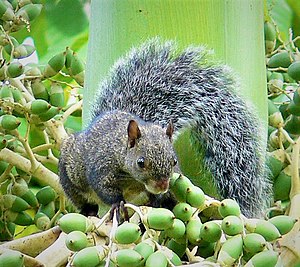Yucatan croissants
| Yucatan croissants | ||||||||||||
|---|---|---|---|---|---|---|---|---|---|---|---|---|

Yucatan squirrel in Belize ( Sciurus yucatanensis phaeopus ) |
||||||||||||
| Systematics | ||||||||||||
|
||||||||||||
| Scientific name | ||||||||||||
| Sciurus yucatanensis | ||||||||||||
| JA Allen , 1877 |
The Yucatan squirrel ( Sciurus yucatanensis ) is a species of squirrel from the genus of squirrels ( Sciurus ). It occurs on the Yucatán Peninsula in parts of Mexico , northern Guatemala, and Belize .
features
The Yucatan squirrel reaches a head-torso length of around 20.0 to 32.2 centimeters. The tail becomes 19.4 to 17.1 centimeters long and is thus slightly shorter than the rest of the body. The back fur of the animals is greyish-colored to black and white, often with a yellow-brown or olive-brown wash. The animals often have a sand-colored spot behind their eyes. The ventral side is sand-colored or gray to grayish-black or black. The feet are dark brown to blackish brown or black. The tail is black and interspersed with white or sand-colored hair.
distribution
The Yucatan croissant is found on the Yucatán Peninsula in parts of Mexico, northern Guatemala, and Belize. The altitude distribution ranges from sea level in the lowlands to around 750 meters.
Way of life
The Yucatan squirrel lives in tropical deciduous and evergreen forests, in semi- arid pine-oak forests of the distribution area and in secondary forest stands . It also occurs in mangrove swamps and in agricultural coffee and cocoa plantations . The animals are diurnal and primarily tree-living. They can be seen moving through the leaf canopy, especially in the morning, while they rest in the branches during the hotter times of the day. They feed mainly on soft fruits, nuts, seeds, flowers, buds and fresh twigs.
The nests (Kobel) are built by the Yucatan croissants in the tall branches of the trees. The young are born during the dry season from April to July, and a litter consists of two to three young.
The main predators for the squirrels are birds of prey, plus cats, dogs, raccoons , primates and snakes.
Systematics
The Yucatan squirrel is classified as an independent species within the genus of squirrels ( Sciurus ), which consists of almost 30 species. The first scientific description comes from Joel Asaph Allen from 1877, who described the species as a variation of the gray squirrel ( S. carolinensis ) using individuals from Mérida in the Mexican state of Yucatán . Daniel Giraud Elliot described it as a species of its own in 1896.
Within the species, together with the nominate form, three subspecies are distinguished:
- Sciurus yucatanensis yucatanensis : nominate form; occurs mainly in the north of the Yucatán peninsula in Mexico. Compared to the other subspecies, this form is significantly lighter.
- Sciurus yucatanensis baliolus : In the central area of the peninsula, especially in the south of Campeche . This shape is also comparatively light. The animals have a sand-colored belly and no dark spots on the base of their ears.
- Sciurus yucatanensis phaeopus : In the southern area of the peninsula in Guatemala, Belize and the southernmost part of the Mexican range. It is the darkest shape with black legs, black spots at the base of the ear and a gray-black belly.
Status, threat and protection
The Yucatan croissant is classified by the International Union for Conservation of Nature and Natural Resources (IUCN) as "not endangered" (least concern). This is justified with the relatively large distribution area, the assumed high population figures and occurrence in several protected areas as well as the ability to adapt to changes in habitat.
Potential sources of danger for the stocks are not known, but the area of distribution is increasingly subject to fragmentation through deforestation into agricultural areas. The animals are also hunted, especially in the Mexican states of Yucatán and Quintana Roo .
supporting documents
- ↑ a b c d e f g Richard W. Thorington Jr. , John L. Koprowski, Michael A. Steele: Squirrels of the World. Johns Hopkins University Press, Baltimore MD 2012, ISBN 978-1-4214-0469-1 , pp. 76-77 .
- ↑ a b c d Sciurus yucatanensis in the IUCN Red List of Threatened Species 2015.1. Listed by: E. Vázquez, L. Emmons, F. Reid, AD Cuarón, 2008. Retrieved July 11, 2015.
- ↑ a b Sciurus yucatanensis In: Don E. Wilson , DeeAnn M. Reeder (Ed.): Mammal Species of the World. A taxonomic and geographic Reference. 2 volumes. 3. Edition. Johns Hopkins University Press, Baltimore MD 2005, ISBN 0-8018-8221-4 .
- ^ A b Troy L. Best , Hugo A. Ruiz-Peña, Livia S. Leon-Paniagua: Sciurus yucatanensis. Mammalian Species 506, October 20, 1995 ( full text )
literature
- Richard W. Thorington Jr. , John L. Koprowski, Michael A. Steele: Squirrels of the World. Johns Hopkins University Press, Baltimore MD 2012, ISBN 978-1-4214-0469-1 , pp. 76-77 .
- Troy L. Best , Hugo A. Ruiz-Peña, Livia S. Leon-Paniagua: Sciurus yucatanensis. Mammalian Species 506, October 20, 1995 ( full text )
Web links
- Sciurus yucatanensis inthe IUCN Red List of Threatened Species 2015.1. Listed by: E. Vázquez, L. Emmons, F. Reid, AD Cuarón, 2008. Retrieved July 11, 2015.